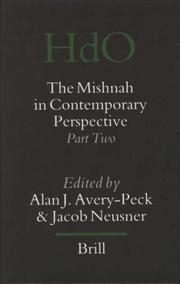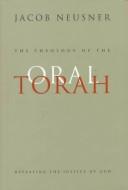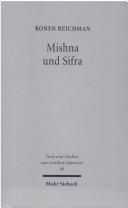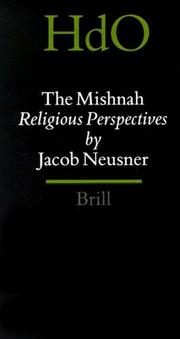| Listing 1 - 10 of 16 | << page >> |
Sort by
|

ISBN: 9004152202 9004125159 9789004152205 9786611399689 128139968X 9047410068 9004294228 9789004125155 9789004294226 9789047410065 Year: 2006 Volume: 65, 87 Publisher: Leiden Boston Brill
Abstract | Keywords | Export | Availability | Bookmark
 Loading...
Loading...Choose an application
- Reference Manager
- EndNote
- RefWorks (Direct export to RefWorks)
This second volume of a two-part project on the Mishnah displays a broad selection of approaches to the study of the Mishnah in the contemporary academy. The work derives from Israel, North America, and Europe and shows the intellectual vitality of scholarship in all three centers of learning. What these articles show in diverse ways is that the Mishnah forms a critical focus of the study of Judaism. The authors of these studies represent the best of contemporary scholarship on the Mishnah. Because of the many viewpoints included here, this is the most representative selection of contemporary Mishnah-study available in any collection in a Western language.
Mishnah --- 296*21 --- Misjna --- 296*21 Misjna --- Criticism, interpretation, etc --- History --- Criticism, interpretation, etc. --- History. --- Mishna --- Mishnayot --- Mischnajot --- Mischna --- Mishne --- Michnah --- Mišnâh --- Mišna --- Mishnayoth --- Mishno --- Shishah sidre Mishnah --- משנה --- ששה סדרי משנה --- משניות
Book
ISBN: 1555407137 Year: 1992 Volume: vol 47 Publisher: Atlanta Scholars Press
Abstract | Keywords | Export | Availability | Bookmark
 Loading...
Loading...Choose an application
- Reference Manager
- EndNote
- RefWorks (Direct export to RefWorks)
296*212 --- Rabbinical literature --- -Hebrew literature --- Jewish literature --- Tosefta --- History and criticism --- -Tosefta --- 296*212 Tosefta --- -296*212 Tosefta --- Mishnah --- Tosephta --- Thoseftha --- Mishna --- Mishnayot --- Mischnajot --- Mischna --- Mishne --- Michnah --- Mišnâh --- Mišna --- Mishnayoth --- Mishno --- Criticism, interpretation, etc. --- Comparative studies. --- Criticism, Redaction. --- Introductions. --- Comparative studies --- Criticism [Redaction ] --- Introductions --- Shishah sidre Mishnah --- משנה --- ששה סדרי משנה --- משניות
Book
ISBN: 1555408729 Year: 1993 Volume: 83 Publisher: Atlanta Scholars Press
Abstract | Keywords | Export | Availability | Bookmark
 Loading...
Loading...Choose an application
- Reference Manager
- EndNote
- RefWorks (Direct export to RefWorks)
296 <08> --- Judaism --- -Jews --- Religions --- Semites --- Jews --- Judaïsme. Jodendom--Verzamelwerken. Reeksen --- History --- -Religion --- Religion --- Sanders, E. P. --- Sanders, Ed, --- -Judaïsme. Jodendom--Verzamelwerken. Reeksen --- -Sanders, E. P. --- Mishnah --- Mishna --- Mishnayot --- Mischnajot --- Mischna --- Mishne --- Michnah --- Mišnâh --- Mišna --- Mishnayoth --- Mishno --- Criticism, interpretation, etc. --- Criticism, interpretation, etc --- Talmudic period, 10-425 --- Shishah sidre Mishnah --- משנה --- ששה סדרי משנה --- משניות
Book
ISBN: 9789004347014 9004347011 9789004347021 900434702X Year: 2017 Volume: 55 Publisher: Leiden Brill
Abstract | Keywords | Export | Availability | Bookmark
 Loading...
Loading...Choose an application
- Reference Manager
- EndNote
- RefWorks (Direct export to RefWorks)
In For Out of Babylonia Shall Come Torah and the Word of the Lord from Nehar Peqod , Barak S. Cohen reevaluates the evidence in Tannaitic and Amoraic literature of an independent “Babylonian Mishnah” which originated in the proto-talmudic period. The book focuses on an analysis of the most notable halakhic corpora that have been identified by scholars as originating in the Tannaitic period or at the outset of the amoraic. If indeed such an early corpus did exist, what are its characteristics and what, if any, connection does it have with the parallel Palestinian collections? Was this Babylonian Mishnah created in order to harmonize the Palestinian Mishnah with a corpus of rabbinic teachings already existent in Babylonia? Was this corpus one of the main contributors to the forced interpretations and resolutions found so frequently in the Bavli?
296*2 --- 296*2 Misjna. Talmud. Halachische codices . Responsen --- Misjna. Talmud. Halachische codices . Responsen --- Rabbinical literature --- Tannaim. --- Amorites. --- Judaism --- Rabbinical literature. --- Tanaim --- Tanaites --- Midrash --- Rabbis --- Amoraim --- Hebrew literature --- Jewish literature --- History and criticism. --- History --- Talmudic period. --- Talmudic period --- Mishnah --- Mishnah. --- Mishna --- Mishnayot --- Mischnajot --- Mischna --- Mishne --- Michnah --- Mišnâh --- Mišna --- Mishnayoth --- Mishno --- History. --- 10-425

ISBN: 1282855395 9786612855399 0773567542 9780773567542 0773518029 9780773518025 9781282855397 6612855398 Year: 1999 Publisher: Montreal Ithaca
Abstract | Keywords | Export | Availability | Bookmark
 Loading...
Loading...Choose an application
- Reference Manager
- EndNote
- RefWorks (Direct export to RefWorks)
"The Theology of the Oral Torah demonstrates the cogency and inner rationality of the classical statement of Judaism in the Oral Torah, bringing a theological assessment to bear on the whole of rabbinic literature. Jacob Neusner shows how the proposition that God is One and all-powerful but also merciful and just defines the system and structure of rabbinic Judaism. He argues that in working this proposition out in rich detail the classical texts generate the central rabbinic problem: how can the conflicting traits inherent in the proposition be resolved?"--Jacket
Judaism --- God --- Jewish theology --- Theology, Jewish --- Justice of God --- Righteousness --- Doctrines. --- Righteousness. --- Justice --- Attributes --- Mishnah --- Mishna --- Mishnayot --- Mischnajot --- Mischna --- Mishne --- Michnah --- Mišnâh --- Mišna --- Mishnayoth --- Mishno --- Criticism, interpretation, etc. --- Shishah sidre Mishnah --- משנה --- ששה סדרי משנה --- משניות --- Criticism, interpretation, etc --- Doctrines --- God (Judaism)

ISSN: 07218753 ISBN: 316146897X 9783161468971 Year: 1998 Volume: 68 Publisher: Tübingen Mohr Siebeck
Abstract | Keywords | Export | Availability | Bookmark
 Loading...
Loading...Choose an application
- Reference Manager
- EndNote
- RefWorks (Direct export to RefWorks)
Comparative literature --- Jewish religion --- Mishnah --- Sifra --- Criticism, interpretation, etc. --- 296*132 --- 296*21 --- Sifra op Leviticus --- Misjna --- Sifra de-vei Rav --- Sifra de-ve Rav --- Torat Kohanim --- Midrash Sifra --- Sifra on Leviticus --- Torat ha-Kohanim --- Sefer Torat Kohanim --- Sifra Torat Kohanim --- Mishna --- Mishnayot --- Mischnajot --- Mischna --- Mishne --- Michnah --- Mišnâh --- Mišna --- Mishnayoth --- Mishno --- 296*21 Misjna --- 296*132 Sifra op Leviticus --- Shishah sidre Mishnah --- משנה --- ששה סדרי משנה --- משניות

ISBN: 1555406041 Year: 1991 Volume: vol 24 Publisher: Atlanta Scholars Press
Abstract | Keywords | Export | Availability | Bookmark
 Loading...
Loading...Choose an application
- Reference Manager
- EndNote
- RefWorks (Direct export to RefWorks)
296*23 --- Talmudcommentaren --- 296*23 Talmudcommentaren --- Mishnah --- Talmud --- Talmud Bavli --- Babylonian Talmud --- Talmud, Babylonian --- Talmud Vavilonskiĭ --- Talmoed, Babylonische --- Babylonische Talmoed --- Shas --- Shishah sedarim --- Talmud of Babylonia --- Talmud de Babilonia --- Talmud Babli --- Talmouth --- Talmod --- Mishna --- Mishnayot --- Mischnajot --- Mischna --- Mishne --- Michnah --- Mišnâh --- Mišna --- Mishnayoth --- Mishno --- Comparative studies. --- Criticism, Redaction. --- Criticism [Redaction ] --- Comparative studies --- Talmud - Criticism, Redaction. --- Talmud - Comparative studies. --- Mishnah - Comparative studies. --- Shishah sidre Mishnah --- משנה --- ששה סדרי משנה --- משניות
Book
ISBN: 1555406386 Year: 1991 Volume: vol 31 Publisher: Atlanta Scholars Press
Abstract | Keywords | Export | Availability | Bookmark
 Loading...
Loading...Choose an application
- Reference Manager
- EndNote
- RefWorks (Direct export to RefWorks)
Traditie (Jodendom) --- Tradition (Judaism) --- Tradition (Judaïsme) --- 296*2 --- Misjna. Talmud. Halachische codices . Responsen --- 296*2 Misjna. Talmud. Halachische codices . Responsen --- Rabbinical literature --- Halacha --- Halakha --- Oral law (Judaism) --- Oral tradition (Judaism) --- Zugot --- History and criticism --- Mishnah --- Mishna --- Mishnayot --- Mischnajot --- Mischna --- Mishne --- Michnah --- Mišnâh --- Mišna --- Mishnayoth --- Mishno --- Evidences, authority, etc. --- Mishnah - Evidences, authority, etc. --- Rabbinical literature - History and criticism. --- Tradition (Judaism. --- Shishah sidre Mishnah --- משנה --- ששה סדרי משנה --- משניות
Book
ISBN: 1555407501 Year: 1992 Volume: vol 53 Publisher: Atlanta Scholars Press
Abstract | Keywords | Export | Availability | Bookmark
 Loading...
Loading...Choose an application
- Reference Manager
- EndNote
- RefWorks (Direct export to RefWorks)
296*23 --- Talmudcommentaren --- 296*23 Talmudcommentaren --- Mishnah --- Talmud --- Talmud Bavli --- Babylonian Talmud --- Talmud, Babylonian --- Talmud Vavilonskiĭ --- Talmoed, Babylonische --- Babylonische Talmoed --- Shas --- Shishah sedarim --- Talmud of Babylonia --- Talmud de Babilonia --- Talmud Babli --- Talmouth --- Talmod --- Mishna --- Mishnayot --- Mischnajot --- Mischna --- Mishne --- Michnah --- Mišnâh --- Mišna --- Mishnayoth --- Mishno --- Criticism, interpretation, etc. --- Criticism, Redaction. --- Sources. --- Talmud. Mo'ed katan --- Criticism, interpretation, etc --- Talmud. Mo ed katan - Criticism, interpretation, etc. --- Shishah sidre Mishnah --- משנה --- ששה סדרי משנה --- משניות

ISSN: 01699423 01699423 ISBN: 9004114920 9004294112 9789004114920 9789004294110 Year: 1999 Volume: 45 Publisher: Leiden Brill
Abstract | Keywords | Export | Availability | Bookmark
 Loading...
Loading...Choose an application
- Reference Manager
- EndNote
- RefWorks (Direct export to RefWorks)
Condensing research concerning questions of religion which encompass the social history of ideas and the religious uses of language, this book deals with three questions: the relationship of the Mishnah to Scripture, the relationship of the religious ideas people hold to the world in which they live, and the religious meaning of the formalization of language that characterizes the Mishnah in particular. In discussing how the Mishnah relates to Scripture - in the (later) mythic language of Rabbinic Judaism: 'the oral Torah' to 'the written Torah' - a complete analysis is presented, based on a systematic application of a single taxonomic program. Then an examination is made of how the stages in the unfolding of the Halakhah of the Mishnah relate to the principal events of the times, which delineate those stages. Here focus is given to those pre-70 C.E. components of the Halakhah that later come to the surface in the Mishnah, but discussion extends to the periods from the destruction of the Temple in 70 C.E. to the Bar Kokhba War, concluded in circa 135 C.E., then from the reconstruction, 135 C.E., to the closure of the Mishnah, 200 C.E. Finally attention is given to methods of interpreting the rhetorical forms of the Mishnah in the context of the social culture laid bare by the socio-linguistics of the documents concerned. This publication has also been published in paperback, please click here for details.
Judaism --- Judaïsme --- History --- Histoire --- Mishnah --- Criticism, interpretation, etc. --- 296*21 --- -296.123 --- Jews --- Religions --- Semites --- Misjna --- -Religion Judaism Mishnah --- Religion --- 296*21 Misjna --- Judaïsme --- 296.123 --- Religion Judaism Mishnah --- Mishna --- Mishnayot --- Mischnajot --- Mischna --- Mishne --- Michnah --- Mišnâh --- Mišna --- Mishnayoth --- Mishno --- Criticism, interpretation, etc --- Talmudic period, 10-425 --- Shishah sidre Mishnah --- משנה --- ששה סדרי משנה --- משניות --- Judaism - History - Talmudic period, 10-425. --- Talmudic period. --- Mishnah. --- 10 - 425
| Listing 1 - 10 of 16 | << page >> |
Sort by
|

 Search
Search Feedback
Feedback About UniCat
About UniCat  Help
Help News
News